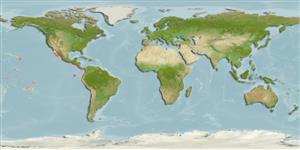Teleostei (teleosts) >
Eupercaria/misc (Various families in series Eupercaria) >
Labridae (Wrasses) > Corinae
Etymology: Halichoeres: Greek, als, alis = salt + Greek, choiros = pig (Ref. 45335).
More on author: Günther.
Environment: milieu / climate zone / depth range / distribution range
Ecology
Marine; reef-associated; depth range 0 - 10 m (Ref. 9311). Tropical; 32°N -
Eastern Pacific: Bahía Magdalena, Mexico south to Peru, including the Galapagos Islands.
Size / Weight / Age
Maturity: Lm ? range ? - ? cm
Max length : 25.4 cm TL male/unsexed; (Ref. 5592); common length : 15.0 cm TL male/unsexed; (Ref. 55763)
Common in shallow waters, especially where brown algae exists (Ref. 9311). Diet consists of crustaceans, sea urchins, mollusks, and brittle stars. It loses its blue-green coloration, turns dull brown in captivity.
Life cycle and mating behavior
Maturities | Reproduction | Spawnings | Egg(s) | Fecundities | Larvae
Distinct pairing during breeding (Ref. 205).
Thomson, D.A., 1987. Reef fishes of the Sea of Cortez. The rocky-shore fishes of the Gulf of California. The University of Arizona Press, Tucson. 302 p. (Ref. 5592)
IUCN Red List Status (Ref. 130435)
Threat to humans
Harmless
Human uses
Tools
Special reports
Download XML
Internet sources
Estimates based on models
Preferred temperature (Ref.
123201): 22.4 - 29.1, mean 26.8 °C (based on 245 cells).
Phylogenetic diversity index (Ref.
82804): PD
50 = 0.5000 [Uniqueness, from 0.5 = low to 2.0 = high].
Bayesian length-weight: a=0.00955 (0.00451 - 0.02020), b=3.09 (2.92 - 3.26), in cm total length, based on LWR estimates for this Genus-body shape (Ref.
93245).
Trophic level (Ref.
69278): 3.5 ±0.43 se; based on food items.
Resilience (Ref.
120179): Medium, minimum population doubling time 1.4 - 4.4 years (Preliminary K or Fecundity.).
Fishing Vulnerability (Ref.
59153): Low vulnerability (15 of 100).
Nutrients (Ref.
124155): Calcium = 64.9 [38.4, 108.0] mg/100g; Iron = 0.625 [0.358, 1.166] mg/100g; Protein = 18.6 [15.8, 20.9] %; Omega3 = 0.128 [0.081, 0.199] g/100g; Selenium = 20.2 [12.2, 37.0] μg/100g; VitaminA = 126 [38, 457] μg/100g; Zinc = 1.53 [1.07, 2.41] mg/100g (wet weight);
